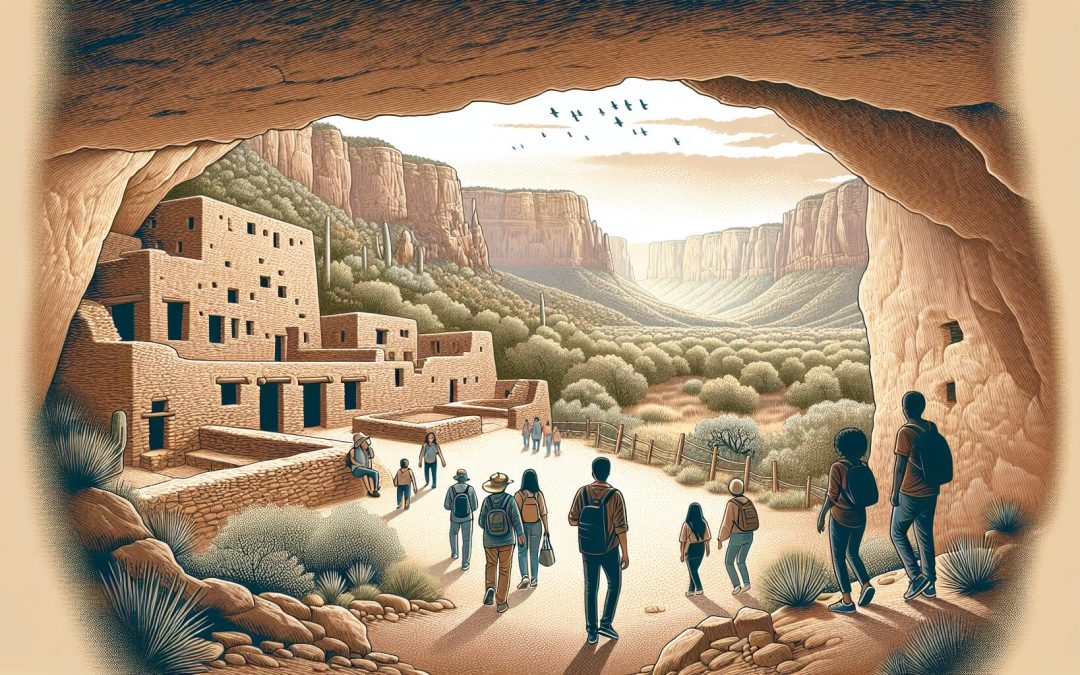Nestled in the rugged terrain of the Tonto Basin in Arizona, Tonto National Monument is a hidden gem that’s been whispering the tales of ancient civilizations for centuries. I recently had the chance to explore these fascinating cliff dwellings, just a stone’s throw away from Scottsdale, and let me tell you, it’s an experience that’s as enlightening as it is breathtaking.
The monument offers a rare glimpse into the lives of the Salado people who called these cliffs home over 700 years ago. Walking through the ruins, I couldn’t help but feel a deep connection to the past, imagining the bustling community that once thrived in these very walls. It’s a place where history isn’t just learned; it’s felt.
Exploration of Tonto National Monument
My adventure to Tonto National Monument began early in the morning, the air tinged with the cool freshness that promises an extraordinary day ahead. As I embarked on the trail leading to the cliff dwellings, the rising sun painted the sky in hues of orange and pink, a spectacle that seemed to welcome me to this sacred place.
The trail to the dwellings is not just a path but a journey through time. With every step, I could sense the echo of ancient footsteps that once tread the same ground. The surrounding landscape, marked by the rugged beauty of the Tonto Basin, offered breathtaking views that demanded frequent stops, not just for rest, but to truly soak in the magnificence of the place.
Upon reaching the cliff dwellings, I was struck by a profound sense of awe. The intricate architecture, built with hands that knew the earth intimately, stands as a testament to the ingenuity and resilience of the Salado people. The dwellings, nestled within the cliffs, seemed to whisper tales of a time long gone, yet preserved so meticulously within these ancient walls.
Within the dwellings, every room, every artifact, and every carving brought me closer to understanding the daily lives of the inhabitants. I could almost hear the murmur of conversations and laughter that once filled these spaces. The experience was not just about observing; it was about connecting with a history that felt so distant yet strangely familiar.
Exploring Tonto National Monument was a reminder of the timeless bond between humanity and nature, a bond that the Salado people embodied so well. It’s a place where history is not just learned but felt, offering insights into a past that continues to influence the present.
History of the Salado People

As I delved deeper into the heart of the Tonto National Monument and the imposing cliff dwellings that overlook the Tonto Basin, I couldn’t help but feel a sense of wonder about the people who crafted these remarkable structures centuries ago. The Salado people, a term coined from the Spanish name for the Salt River in the area, have fascinated historians and archaeologists alike with their unique culture and advanced societal structures.
The origins of the Salado culture trace back to around 1150 CE, thriving through to the 15th century. What sets the Salado apart in the annals of history is their remarkable ability to blend architectural and cultural elements from various neighboring communities, including the Hohokam, Mogollon, and Ancient Puebloans (Anasazi). This fusion created a distinct societal fabric that was rich in agricultural innovation, craftsmanship, and trade networks that stretched far beyond the bounds of what we now consider the American Southwest.
Key Insights About the Salado People:
- Remarkable Adaptability: The Salado practiced advanced irrigation techniques, cultivating corn, beans, squash, and cotton, which were vital for their survival and the backbone of their economy.
- Artistic Expression: They were also known for their exquisite pottery and intricate textile work, which are still admired for their sophistication and beauty.
- Trade Networks: Their strategic location allowed them to become a hub for trade, connecting the cultures of the northern and southern regions and facilitating the exchange of ideas, goods, and cultural practices.
One can’t talk about the Salado without mentioning the cliff dwellings themselves. Built into the alcoves of the Tonto Basin’s cliffs, these structures were not just homes; they were a testament to the Salado’s architectural ingenuity and deep spiritual connection to their environment. The dwellings, constructed from natural materials such as stone, clay, and timber, have stood the test of time, offering us a glimpse into the daily lives of the Salado people.
Exploring the remains of the Salado culture at Tonto National Monument, I was struck by their resilience and innovation. Their legacy is a reminder of the transient nature of civilizations and the indelible marks they leave behind on both the landscape and collective human memory.
Architecture of the Cliff Dwellings
When I first laid eyes on the cliff dwellings at Tonto National Monument, the sheer ingenuity and architectural prowess of the Salado people were undeniable. Nestled within the natural alcoves of the towering cliffs, these ancient homes are a testament to a deep understanding of their environment and the resources it offered.
The dwellings were predominantly constructed from tuff, a type of volcanic rock, and mud mortar. This choice of materials not only provided excellent insulation against the harsh desert temperatures but was also readily available in the surrounding landscape. The resilience of these materials is evident, with structures still standing centuries later.
Each dwelling was carefully designed to maximize space and functionality. The interior space was cleverly utilized, featuring living areas, storage spaces, and religious kivas. Interestingly, the kivas, which were ceremonial rooms, played a central role in the community, underscoring the spiritual connection the Salado people had with their surroundings.
What’s more, the strategic placement of these dwellings high above the ground served multiple purposes. It offered protection against predators and flooding while also providing a vantage point that could have been used for surveillance and to signal other communities. This multifaceted approach to their living environment showcases not just architectural skill but a profound mastery over their environment.
Walking through the crumbling ruins, I couldn’t help but marvel at the narrow passageways and intricate staircases carved directly into the rock, connecting the different levels of the cliff dwellings. These pathways demonstrated the community’s adaptability and their ability to work within the constraints of their cliffside canvas.
The way the Salado people integrated their homes into the natural landscape, preserving and utilizing every inch of space, speaks volumes about their respect for nature and their resourcefulness. Their legacy, embedded in the stones of Tonto National Monument, continues to fascinate and teach us about sustainable living and architectural innovation.
Preservation Efforts and Visitor Information
I’ve always believed that the preservation of historical sites isn’t just about keeping the past alive but it’s also a homage to the ingenuity and resilience of those who came before us. Tonto National Monument is no exception. The efforts to maintain the site have been both extensive and inspiring. Experts in archaeology and conservation work tirelessly to ensure that the cliff dwellings remain as intact as possible for future generations. This involves not only physical restoration work but also monitoring the impact of environmental factors such as weathering and erosion.
Besides the physical preservation, there’s also a strong emphasis on educational programs. These initiatives aim to teach visitors about the Salado culture and the significance of the dwellings. I find it particularly impactful that the site uses guided tours to convey the stories of the ancient inhabitants, allowing guests to connect on a deeper level with the history of the area.
| Visitor Information | Details |
|---|---|
| Opening Hours | 8 AM – 5 PM (varies by season) |
| Admission Fee | $10 per person (children under 15 free) |
| Guided Tours Availability | Limited; reservation recommended |
| Accessibility | ADA accessible paths to lower ruins |
| Recommended Visit Duration | 2-3 hours |
For those planning a visit, it’s important to note that the best times to explore the monument are during the cooler months, from November to April, when the Arizona heat is more bearable. Bringing water, sunscreen, and comfortable walking shoes is a must. Although the trails are well-maintained, the terrain can be challenging for some.
The visitor center, equipped with exhibits and a gift shop, offers a plethora of information, making it the perfect starting point for your adventure. Whether you’re a history buff, an architecture enthusiast, or simply someone looking to connect with ancient cultures, Tonto National Monument offers an immersive peek into the past without the need for a time machine.
Experiencing the Past at Tonto National Monument

Visiting Tonto National Monument feels like stepping back in time. As I wander through the ancient Salado cliff dwellings, the centuries-old walls whisper stories of a civilization that once thrived in the arid landscape. The Salado people ingeniously cultivated the land, harvested rainwater, and created a flourishing community, their legacy etched into every stone and artifact.
For anyone fascinated by history, guided tours are indispensable. These tours offer insights that you can’t get from reading plaques. The knowledgeable rangers share details about the Salado culture’s daily life, their agricultural practices, and the architectural marvels of constructing homes within cliffs. It’s amazing to learn how these ancient peoples adapted to and thrived in such a challenging environment.
Yet, what strikes me most about Tonto National Monument isn’t just the historical significance; it’s the palpable sense of continuity and connection. While exploring the site, I always take a moment to view the panoramic landscapes from the same vantage points the Salado people might have centuries ago. It’s a powerful reminder of the enduring link between the past and present.
Beyond the architecture and artifacts, the Monument’s commitment to conservation shines through. Efforts to preserve the site ensure that visitors will be able to experience this connection for generations to come. I’m encouraged to see the balance between allowing public access and protecting these irreplaceable cultural treasures.
As I delve deeper into the monument, I’m always discovering something new. Whether it’s a petroglyph I hadn’t noticed before or a wildflower growing stubbornly in a rock crevice, Tonto National Monument encapsulates the resilience and beauty of the human spirit. And each visit reminds me why places like this need to be cherished and protected.
Conclusion
Venturing into Tonto National Monument has been an unforgettable journey back in time. Standing where the Salado once stood, I’ve felt a profound connection to the past and a renewed appreciation for the art of preservation. It’s clear that every stone and artifact tells a story, waiting for us to listen. The dedication to conserving this site ensures that these stories endure, offering a glimpse into an ancient way of life that continues to inspire. Let’s keep supporting these efforts, ensuring future generations can also experience the wonder of connecting with our shared human heritage.







